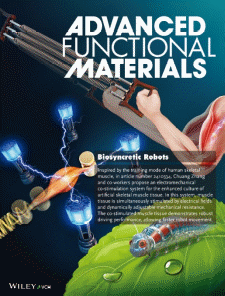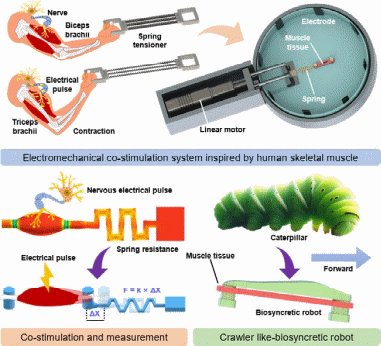
The study was published as a frontispiece
In recent years, biosyncretic robots composed of living and synthetic materials have been proposed and have rapidly become a research hotspot in the field of robotics, and show great potential for applications in tissue engineering, organ-on-a-chip and human medical treatment.
The common living materials used in biosyncretic robots include cardiomyocytes, artificial skeletal muscle tissue (ASMT), insect dorsal vascular tissue, microorganisms and blood cells. Among them, ASMTs are widely used due to their good size scalability, controllability and potential high driving force.
Recently, researchers at the Shenyang Institute of Automation (SIA), Chinese Academy of Sciences (CAS), have developed an electromechanical co-stimulation system inspired by human skeletal muscle training patterns, which can effectively enhance the driving performance of ASMTs. The related research has been published in the form of a frontispiece article in Advanced Functional Materials.
In the human body, skeletal muscle tissues are trained or maintained from the embryo to adulthood by a combination of nerve electrical and mechanical stimulation.The research team mimicked the natural training pattern of human skeletal muscle contracting in response to neuro-electrical pulse stimulation to overcome external loads, applying both electrical and dynamic mechanical stimuli. This can significantly enhance the protein differentiation rate and contraction performance of ASMT, enabling rapid actuation of biosyncretic robot.
The experimental results show that the trained ASMT protein differentiation rate is enhanced by about 50% and the maximum contraction force is enhanced by about 98%, demonstrating a mature muscle sarcomere mechanism similar to that of natural skeletal muscle. Notably, under low load conditions, the maximum contraction strain of the driving part of the ASMT can reach 18%, which is close to the contraction strain of natural skeletal muscle.
To verify the driving performance of ASMT cultured by electromechanical co-stimulation, drawing inspiration from crawling organisms such as caterpillars, a biosyncretic robot was designed. The robot achieved a maximum speed of 2.38 mms−1, setting a record for recently published biosyncretic robots driven by ASMTs.

System Schematic (Image by the research group)
This research was supported by the National Natural Science Foundation of China (NSFC) project, the Key R&D Programme of the Ministry of Science and Technology (MOST) project and the National Key Laboratory of Robotics and Intelligent Systems project.
Link to paper:https://doi.org/10.1002/adfm.202410334